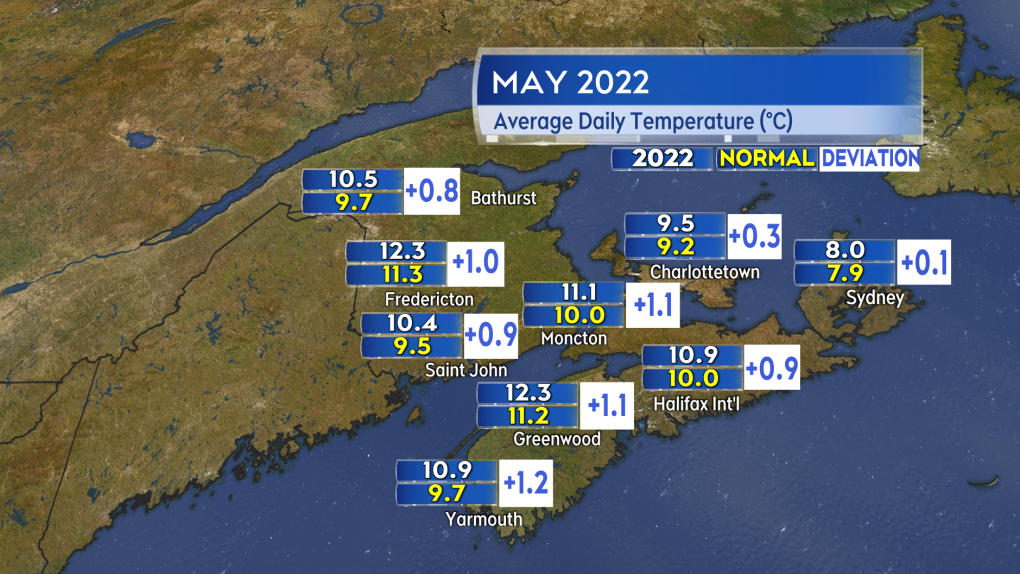Kalin's Call: Maritime provinces experienced a drier-than-average May
 A wildfire is seen near Horseshoe Lake in Yarmouth County on May 11, 2022. (SOURCE: Twitter: Department of Natural Resources)
A wildfire is seen near Horseshoe Lake in Yarmouth County on May 11, 2022. (SOURCE: Twitter: Department of Natural Resources)
The big standout for weather in the Maritimes last month was how dry it was. A good portion of the Maritimes saw only half or less than the 30-year (1981-2010) climate average for the month.
Some of the drier areas included southern New Brunswick, northern and eastern Nova Scotia, and Prince Edward Island.
 It was a dry May 2022 for the Maritime region. Many areas reporting about half or less of the 30 year climate normal in total precipitation.
It was a dry May 2022 for the Maritime region. Many areas reporting about half or less of the 30 year climate normal in total precipitation.
The month actually started on a chilly note when it came to temperatures. Several weather stations in the region recorded new daily record lows on May 7 and May 8. A few days later, a ridge of high pressure sent temperatures soaring upward for the period of May 11-14.
The heat peaked on May 14, with some in New Brunswick and Nova Scotia reporting their first 30-degree temperatures of the year and with P.E.I. reporting into the high 20s. Overall, the month finished with near-to-above average daily temperatures.
 Despite some colder periods at the start of the month by the end of May average daily temperature was near-to-above normal for most.
Despite some colder periods at the start of the month by the end of May average daily temperature was near-to-above normal for most.
Sea surface temperatures surrounding the Maritimes were generally above normal at the end of the month. The greatest departure for coastal areas of the Gulf of St. Lawrence, Northumberland Strait, Cabot Strait, and Bay of Fundy.
 A map of sea surface temperature anomaly (departure from normal) for Atlantic Canada. Reds indicate areas of above normal temperatures and blues below normal.
A map of sea surface temperature anomaly (departure from normal) for Atlantic Canada. Reds indicate areas of above normal temperatures and blues below normal.
Looking ahead, predictive models run by Environment Canada indicate that June is likely to finish with above-normal temperatures and near-normal precipitation. The three-month outlook, which includes June, July, and August predicts above-normal temperatures and below-normal precipitation through that period.
This summary from data and files provided by Environment and Climate Change Canada.
CTVNews.ca Top Stories

107-year-old temperature record among dozens broken across Canada
Canadians are experiencing a wave of warm weather across multiple provinces well into the fall season, shattering dozens of temperature records.
48,584 space heaters recalled in Canada after burn injury in U.S.
Health Canada has announced a recall for electric space heaters over potential fire and burn risks, a notice published Thursday reads.
N.S. school apologizes for asking service members not to wear uniforms at Remembrance Day ceremony
An elementary school in the Halifax area has backed away from a request that service members not wear uniforms to the school's Remembrance Day ceremony.
Canada's permanent employees earning more, according to latest jobs data
Canada added lower-than-expected 14,500 jobs in October and wages of permanent employees rose, data showed on Friday, as the economy grappled to absorb the slack built up due to a rapidly rising population amid an overheated market.
Canada rent report: What landlords are asking tenants to pay
Average asking rents declined nationally on a year-over-year basis for the first time in more than three years in October, said a report out Thursday.
Time limits meant to speed up justice have halted hundreds of criminal cases in Canada
Supporters say the so-called Jordan ruling has sped up proceedings and strengthened Charter rights for prompt justice. But the legacy of Jordan is mixed, and some victims say the time limits work in criminals' favour.
Oven to be removed from Halifax store where employee died: Walmart
Walmart says a large bakery oven will be removed from the Halifax store where an employee died last month.
Prince William calls past year 'incredibly tough'
Prince William has described the past year as "brutal" following cancer diagnoses for his wife and father. "Honestly, it's been dreadful," he said.
Three charged in One Direction singer Liam Payne's death
Three people have been charged in relation to One Direction singer Liam Payne's death in a fall from his Buenos Aires hotel balcony last month, Argentine authorities said on Thursday.


































